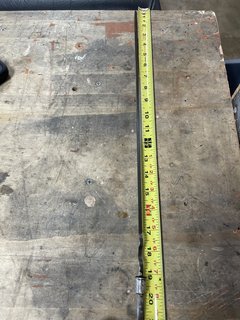It has a 360, and before changing the oil I'd checked the forums for oil capacity - I saw numbers ranging from 5 quarts to 7 quarts, so I started with filling with 5 quarts and then checked the dipstick.
I was flabbergasted at how far up the dipstick the oil level was! It was several inches above the upper "Safe" level (up to red mark)!
I poured the oil from the drain pan into the now-empty jug, and it came up just shy of two quarts!
So I think it's safe to conclude that: 1. The dipstick marks are incorrect, and 2. It has been quite low on oil.
I found Keith's article on dipsticks and I realized that it's a combination of tube length and dipstick that yield the measurement, and that our trucks often have a spotted history with a mix of parts. There are some part markings on my dipstick: EOAE 6750-HA With some Googling, I found that the 6750-HA didn't narrow down the search much at all - no help. The EOAE is interesting because it links to a Ford passenger vehicle engine block code from the 1980s. So is it plausible that I have a dipstick from a 1980s Ford car and that's why the oil level is so far off? Or is something else entirely at work here?
To move forward from here, should I add one more quart of oil (six total) and then mark the dipstick level? Interestingly, while measuring the dipstick I noticed what might be a human-made scratch mark just above the oil level with 5 quarts in it - maybe the owner previous to the previous owner did exactly that?
To wrap up, in case anyone is curious, here are the measurements I took:
Shield to tip: 21 9/16"
Tip to oil level with 5 quarts: 4 7/16"
Oil level to shield: 17 1/8"
Finally, here's a photo of the tube - does it look original to a 360 in a 1969?



